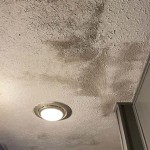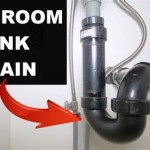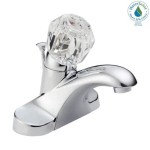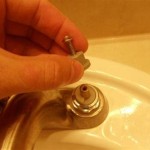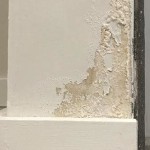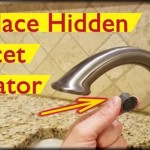Understanding the Bathroom Sink Trap: Function, Types, and Maintenance
The bathroom sink trap, often overlooked beneath the basin, plays a critical role in maintaining a safe and sanitary plumbing system. Its primary function extends beyond simply draining water; it prevents noxious sewer gases from entering the home and traps debris that could potentially clog the drain lines. Understanding the mechanics, types, and proper maintenance of the sink trap is essential for homeowners and plumbing professionals alike.
The sink trap operates based on a simple yet effective principle: creating a water seal. This seal is formed by a curved section of pipe that remains filled with water after each use of the sink. This water barrier effectively blocks the passage of sewer gases, which are not only unpleasant but also potentially harmful, containing methane and other hazardous substances. Furthermore, the trap captures heavier debris like hair, soap scum, and small objects that accidentally fall into the drain. Without a trap, these materials would flow further down the drain lines, increasing the likelihood of blockages and requiring more extensive plumbing repairs.
Key Point 1: The Fundamental Function of a Sink Trap
The primary function of a bathroom sink trap is multifaceted, addressing both hygiene and plumbing system protection. It is more than just a conduit for wastewater; it is a crucial component of a building's overall sanitation system.
Firstly, the trap provides a barrier against sewer gases. These gases, produced by the decomposition of organic matter in the sewage system, contain a variety of potentially dangerous compounds. Hydrogen sulfide, for instance, is a toxic gas that can cause respiratory problems and, in high concentrations, even death. Methane is another component, which is highly flammable and can create an explosion hazard. Ammonia, carbon dioxide, and other volatile organic compounds contribute to the unpleasant odor associated with sewer gases. The water seal within the trap prevents these gases from migrating up the drainpipe and into the living space, thereby protecting the health and well-being of occupants.
Secondly, the sink trap acts as a physical barrier against debris. Hair, soap residue, small objects like jewelry, and other materials often find their way into the sink drain. Without a trap, these items would accumulate further down the drainage system, potentially causing significant blockages. These blockages can lead to slow drainage, foul odors, and, in severe cases, complete plumbing failure. The trap captures these materials, making it easier to remove them during routine maintenance and preventing more serious problems from developing deeper within the plumbing system.
The trap also contributes to the overall efficiency of the plumbing system. By preventing large debris from entering the drain lines, it reduces the frequency of required drain cleaning and maintenance. This, in turn, minimizes the need for costly plumbing repairs and extends the lifespan of the entire drainage system. A properly functioning trap is, therefore, a preventative measure that protects the investment in the plumbing infrastructure.
In summary, the fundamental function of a bathroom sink trap is to protect the occupants of a building from harmful sewer gases, to trap debris that could cause clogs, and to contribute to the overall efficiency and longevity of the plumbing system. Its seemingly simple design belies its importance in maintaining a safe and functional environment.
Key Point 2: Types of Bathroom Sink Traps
Several types of sink traps are commonly used in bathroom installations, each with its own advantages and disadvantages. The most prevalent types are the P-trap, the S-trap (though often discouraged in modern plumbing), and bottle traps.
The
P-trap
is the most widely used and generally recommended type of sink trap. It consists of a U-shaped bend, often called the "trap arm," connected to a drainpipe that extends horizontally to the wall. The U-bend holds the water seal, while the drainpipe directs wastewater towards the main drainage system. P-traps are favored due to their ease of installation, maintenance, and effectiveness in preventing sewer gases from escaping. Their design allows for relatively easy access to clear clogs, often by loosening slip nuts and removing the trap arm.The
S-trap
, although once common, is largely outdated and discouraged by many modern plumbing codes. It resembles a P-trap but features a longer, downward-sloping tailpiece that connects directly to the drainpipe below the floor. The problem with S-traps is their susceptibility to siphonage. When a large volume of water drains quickly, it can create a siphoning effect, pulling the water out of the trap and breaking the water seal. This allows sewer gases to enter the room. For this reason, S-traps are generally replaced with P-traps during renovations or plumbing upgrades.The
bottle trap
, also known as a European trap or a decorative trap, offers a more aesthetically pleasing alternative, particularly in situations where the plumbing is exposed. Instead of a U-bend, bottle traps have a cylindrical body that holds the water seal. They are often made of chrome or other polished materials to complement the bathroom decor. Bottle traps are relatively easy to clean, as the bottom section can be unscrewed to remove accumulated debris. However, they may not be as effective at trapping larger objects compared to P-traps, and their smaller water capacity might make them more susceptible to evaporation and loss of the water seal in infrequently used sinks.Beyond these common types, variations exist, such as deep seal traps, which offer a larger water capacity for enhanced protection against sewer gases in specific applications. The choice of sink trap depends on factors such as the available space, the location of the drainpipe, and aesthetic considerations. However, adherence to local plumbing codes and the prioritization of functionality and reliability are paramount in selecting the appropriate trap.
It's crucial to consult with a qualified plumber when installing or replacing a sink trap to ensure compliance with regulations and proper functionality. Incorrect installation can lead to leaks, inadequate drainage, and the entry of sewer gases into the building.
Key Point 3: Maintenance and Troubleshooting
Regular maintenance is crucial for ensuring the proper functioning and longevity of a bathroom sink trap. Troubleshooting common problems such as clogs and leaks is also an important aspect of home maintenance.
Preventative maintenance
primarily involves periodically cleaning the trap to remove accumulated debris. This can be done by placing a bucket under the trap, carefully loosening the slip nuts that connect the trap arm, and removing the trap. The accumulated debris can then be rinsed out with water. It is advisable to wear gloves during this process. If the trap is particularly dirty, a mild soap solution can be used to clean it thoroughly. After cleaning, the trap should be reassembled carefully, ensuring that the slip nuts are tightened securely, but not overtightened, to prevent leaks.Clogs
are a common issue with sink traps. Slow drainage is often the first sign of a developing clog. If the water drains very slowly or not at all, it is likely that a blockage has formed within the trap. In many cases, a simple plunger can be used to dislodge the clog. If plunging is ineffective, the trap can be disassembled and manually cleared of debris. A bent piece of wire or a small brush can be used to remove stubborn clogs. If the clog persists beyond the trap, a drain snake (auger) may be necessary to clear the drain line further down.Leaks
are another potential problem with sink traps. Leaks often occur at the slip nut connections due to loose fittings or worn-out washers. Tightening the slip nuts may resolve minor leaks. However, if the washers are damaged or deteriorated, they should be replaced. It's important to use the correct size and type of washer for the specific trap to ensure a proper seal. In some cases, the trap itself may be damaged or corroded, requiring replacement. Corrosion is more common in older traps or those made of lower-quality materials.Unusual odors
emanating from the sink drain can indicate a problem with the trap. While a properly functioning trap should prevent sewer gases from entering the room, a loss of the water seal can occur due to evaporation in infrequently used sinks. To remedy this, simply run water into the sink to refill the trap. If the odor persists, it could indicate a more serious plumbing issue, such as a vent problem that is preventing proper airflow and causing sewer gases to back up into the drainage system. In such cases, a qualified plumber should be consulted.Regular inspection of the sink trap is recommended to identify potential problems early on. Look for signs of leaks, corrosion, or damage. Addressing these issues promptly can prevent more significant plumbing problems and ensure the continued efficient operation of the bathroom sink.
In colder climates, it’s also vital to ensure the sink trap is adequately protected from freezing temperatures. Freezing can cause the water in the trap to expand, potentially cracking the pipe. Insulating the pipes or allowing a small trickle of water to run on extremely cold nights can prevent freezing.

How To Unclog A Bathroom Sink Hana S Happy Home

How To Clean Out A Sink Trap Bailey Brothers Plumbing

Traps What Are They Cleaning Amp Installation

5 Natural Ways To Unclog A Bathroom Sink Hiller How

How To Install P Trap And Bathroom Sink Drain Piping Easy Installation For Beginners

Simple Drain 1 25 In Rubber Threaded P Trap Bathroom Single Sink Kit 3ea 1v2 Tc0 The Home Depot

Diy Plumbing Blog How To Clean A Drain Trap

How To Retrieve An Item Dropped Down The Sink Drain In 2024 Bathroom Plumbing Replace

The Best Way To Clean A Sink P Trap Bell Brothers

Bathroom Sink Plumbing Installation Diy Montreal
Related Posts

